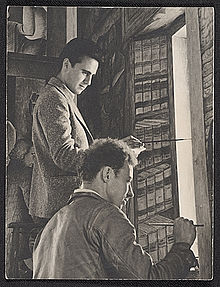Frederick E. Olmsted
Frederick E. Olmsted | |
|---|---|
| Born | Frederick Erskine Olmsted Jr. April 10, 1911 San Francisco, California, U.S. |
| Died | February 14, 1990 (aged 78) |
| Nationality | American |
| Other names | Frederick Erskine Law Olmsted Jr. |
| Education | Stanford University, San Francisco Art Institute, Yale University |
| Known for | Artist, Muralist, Sculptor, Scientist |


Frederick "Fred" Erskine Olmsted, Jr. (April 10, 1911 in San Francisco – February 14, 1990 in Falmouth, Massachusetts) was an American artist and scientist. He created many social realism themed murals and sculptures for the WPA, the FAP and public works in San Francisco[1] and later abandoned his art career and became a scientist and biophysicist.[2][3]
Early life[]
He was the son of Frederick "Fritz" Erskine Olmsted (November 8, 1872 – 1925), a former forest Service employee, published author and advocated for federal regulation over private cutting.[4] His mother was Florence Starbuck du Bois (December 18, 1874) and he had a brother named Julian Olmsted.[4] He was a collateral relative of landscape architect that designed New York City's Central Park, Frederick Law Olmsted.[1][5]
Olmsted Jr. studied science at Stanford University,[6] he was a student of Ralph Stackpole's at the California School of Fine Arts (CSFA) (now called the San Francisco Art Institute or SFAI).[6] It was at California School of Fine Arts where he met and later married Barbara Greene.[6]
Career[]
Olmsted Jr. worked in the WPA, assisting John Langley Howard and George Albert Harris in their Coit Tower murals in San Francisco, and creating his own mural on a three-foot panel called "Power" above the main entrance.[1][6] He also assisted Diego Rivera with his mural at the Art Institute in San Francisco with the theme building a city.[7] Olmsted painted a window archway called "Pottery" in the Anne Bremer Memorial Library at SFAI.[6]
In 1935, he painted a mural at SFAI named "Marble Workers" which depicted tradesmen at work in a Fishermans wharf tile shop, and at some point in history the mural was painted over.[8] In 2013, the "Marble Workers" mural was rediscovered and by September 2019 a Save America’s Treasures grant was awarded to offset the cost of restoration of the mural.[8]
Olmsted Jr. created two large sculptures that stand 7 feet high, four foot square, and of 9 tons of granite, representing Leonardo da Vinci and Thomas Edison for the 1939–1940 Golden Gate International Exposition on Treasure Island.[1] These sculptures were carved for the WPA exhibition "Art in Action". Art in Action was an exhibit of artists at work displayed for four months in the summer of 1940. When the Golden Gate International Exposition was over, the sculptures were donated to CCSF and are currently on display at the CCSF Ocean Campus.[1]
Olmsted Jr. painted the "Theory and Science" mural located at City College of San Francisco (CCSF) in the science building, west entrance in 1941.[6] In 2002, CCSF staff, students and restoration professionals restored the mural. This mural depicts a range of careers in the sciences, featuring both men and women doing things such as viewing bacteria through a microscope, conducting field research, and excavating dinosaur remains.[6]
Later life and death[]
He taught art for a few years at Arts and Crafts in Oakland (now called California College of Art or CCA).[1]
After Barbara and he divorced, he continued to work as a sculptor, and became more interested in studying science. He later abandoned his art career and became a scientist at Yale University and later a biophysicist at the Cleveland Clinic.[2] He designed medical equipment for the Cleveland Clinic and it was there he developed a machine to shock the diseased heart of one of dogs, a prototype for today's pacemaker.[1] Olmsted then worked at Woods Hole, Massachusetts, designing equipment for the Oceanographic Institute.[1]
He died in Falmouth, Massachusetts on February 14, 1990 at the age of 78.[2]
See also[]
- Art in Action, the art exhibition at the Golden Gate International Exposition (GGIE) funded by the WPA
- City College of San Francisco, current location of much of Olmstead's art from the GGIE
- Ralph Stackpole, Olmsted's artistic mentor
References[]
- ^ a b c d e f g h "Edison and DaVinci by Olmsted". ArtAndArchitecture-SF.com. Retrieved September 25, 2014.
- ^ a b c "Frederick Erskine Law, Jr. Olmsted (1911–1990)". www.askart.com. Retrieved September 25, 2014.
- ^ Milton Hughes, Edan (2002). Artists in California, 1786–1940: L-Z, Volume 2. Sacramento: Crocker Art Museum. pp. 832–833.
- ^ a b Newfield, Elsbeth (2006). "773 Dolores (11 Dolores), 1917, Shingle style house" (PDF). Stanford Historical Society. Archived from the original (PDF) on 2015. Retrieved September 25, 2014.
- ^ "Frederick Erskine Olmsted, Jr". FAMSF Search the Collections. 2018-09-21. Retrieved 2019-10-03.
the grandson of Frederick Law Olmsted, the planner of New York's Central Park
- ^ a b c d e f g "Public Art On Campus, Murals". City College of San Francisco (CCSF). Retrieved September 25, 2014.
- ^ Brechin, Grey (2012). "City College of San Francisco "Theory and Science" Mural – San Francisco CA". The Living New Deal. The Living New Deal, Department of Geography at UC Berkeley. Archived from the original on September 26, 2014. Retrieved September 25, 2014.
- ^ a b Whiting, Sam (2019-10-02). "Long-lost New Deal-era fresco at SF Art Institute to be brought to light". Datebook | San Francisco Arts & Entertainment Guide (in American English). Retrieved 2019-10-03.
- 20th-century American painters
- American male painters
- Social realist artists
- 1911 births
- 1990 deaths
- San Francisco Art Institute alumni
- Artists from the San Francisco Bay Area
- American muralists
- Federal Art Project artists
- People from Falmouth, Massachusetts
- American biophysicists